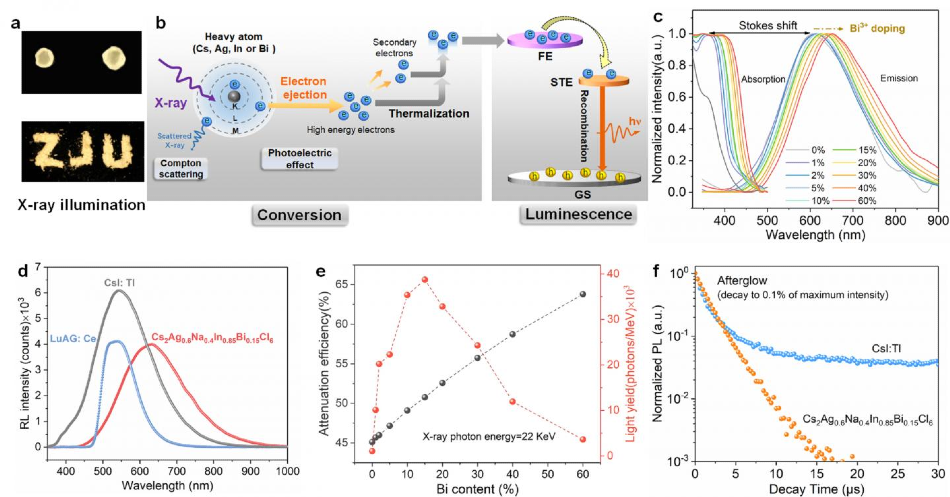Aug 19 2020
Scientific research, medical diagnosis, and industrial material inspection are the main fields where X-ray imaging is actively being used.
 (a) Photographs of Cs2Ag0.6Na0.4In0.85Bi0.15Cl6 single crystals and powder under X-ray illumination. (b) Proposed mechanism of X-ray scintillation in a lead-free halide double perovskite scintillator. (c) Stokes shift of Cs2Ag0.6Na0.4In1−yBiyCl6 with different Bi3+ contents. (d) RL spectra of Cs2Ag0.6Na0.4In0.85Bi0.15Cl6, LuAG:Ce and CsI:Tl wafers. (e) Attenuation efficiency and light yield of Cs2Ag0.6Na0.4In1−yBiyCl6 versus Bi3+ content. (f) Afterglow curves of Cs2Ag0.6Na0.4In0.85Bi0.15Cl6 and CsI:Tl. Image Credit: Wenjuan Zhu, Wenbo Ma, Yirong Su, Zeng Chen, Xinya Chen, Yaoguang Ma, Lizhong Bai, Wenge Xiao, Tianyu Liu, Haiming Zhu, Xiaofeng Liu, Huafeng Liu, Xu Liu, and Yang (Michael) Yang.
(a) Photographs of Cs2Ag0.6Na0.4In0.85Bi0.15Cl6 single crystals and powder under X-ray illumination. (b) Proposed mechanism of X-ray scintillation in a lead-free halide double perovskite scintillator. (c) Stokes shift of Cs2Ag0.6Na0.4In1−yBiyCl6 with different Bi3+ contents. (d) RL spectra of Cs2Ag0.6Na0.4In0.85Bi0.15Cl6, LuAG:Ce and CsI:Tl wafers. (e) Attenuation efficiency and light yield of Cs2Ag0.6Na0.4In1−yBiyCl6 versus Bi3+ content. (f) Afterglow curves of Cs2Ag0.6Na0.4In0.85Bi0.15Cl6 and CsI:Tl. Image Credit: Wenjuan Zhu, Wenbo Ma, Yirong Su, Zeng Chen, Xinya Chen, Yaoguang Ma, Lizhong Bai, Wenge Xiao, Tianyu Liu, Haiming Zhu, Xiaofeng Liu, Huafeng Liu, Xu Liu, and Yang (Michael) Yang.
A scintillator is the main component that helps detect X-rays. Through this component, X-ray photons can be converted into visible photons and these can be subsequently identified by a photodiode array. But in spite of years of intensive studies performed on scintillators, the performances of traditional scintillators are far from perfect even today.
Although the emerging lead halide perovskite has started to exhibit highly potential properties, many unpleasant factors continue to persist, such as comparatively low light yield, strong self-absorption, and lead toxicity that restrict the practical application of these perovskites.
A group of researchers and colleagues have designed a new, nontoxic Cs2Ag0.6Na0.4In0.85Bi0.15Cl6 double perovskite scintillator that not only exhibits a high light yield but also shows long-lasting stability under constant X-ray irradiation and thermal treatment.
The team was headed by Professor Yang Yang from State Key Laboratory of Modern Optical Instrumentation, College of Optical Science and Engineering, International Research Center for Advanced Photonics, Zhejiang University in China. The study was published in the Light: Science & Application journal.
Considering the rapid light decay and high light output of the novel scintillator, the researchers achieved static X-ray imaging under a very low dose of ~1 μGyair, and also demonstrated dynamic X-ray imaging of finger bending without any ghosting effect under a low dose speed of 47.2 μGyair per second.
These outcomes demonstrate the excellent potential of studying scintillators beyond the emerging lead halide perovskites, not only to prevent toxic elements but also to achieve better performance.
Since scintillators can convert X-ray photons into visible photons, the reasonable mechanism of X-ray scintillation can be explained as follows:
The heavy atoms of the scintillators initially absorb the radiation energy, predominantly through inelastic Compton scattering and the photoelectric effect, ejecting enormous hot electrons; these electrons subsequently thermalize on an ultrafast timescale and are finally captured by luminescent centers.
The researchers summed up the design principles of the scintillator as follows:
We design the scintillator according to the following three principles:(1) Introduce heavy atom (Bi3+) to improve X-ray absorption efficiency; (2) Weaken self-absorption and improve photoluminescence quantum yield to optimize light out; (3) Reduce afterglow and shorten light decay time to increase the signal-to-noise ratio (SNR) of X-ray imaging.
The Researchers, Changchun Institute of Optics, Fine Mechanics and Physics, Chinese Academy
“The realization of high-resolution X-ray image under an extreme low X-ray dose demonstrate that the X-ray dose requirement for medical X-ray imaging can be significantly reduced in the future,” added the team.
The presented scintillators can be used in X-ray computed tomography (CT) and dynamic X-ray imaging, which is important to understand many biological processes and is also useful for online monitoring of industrial process.
The Researchers, Changchun Institute of Optics, Fine Mechanics and Physics, Chinese Academy
Journal Reference:
Zhu, W., et al. (2020) Low-dose real-time X-ray imaging with nontoxic double perovskite scintillators. Light: Science & Applications. doi.org/10.1038/s41377-020-00353-0.